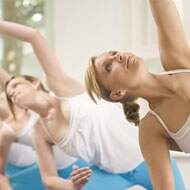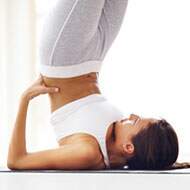Exercising after menopause
Exercising after menopause
As you age, you may feel that maintaining a healthy weight range becomes a lot more difficult. Studies show that most women tend to gain weight, especially around the waist, when they are going through menopause. Fortunately, it is possible for you to shed the excessive fat by following a proper workout routine, even as you approach menopause. Given below are some healthy post menopause exercise options:
- Walking briskly
- Running or jogging
- Playing tennis
- Swimming
- Cycling
- Cross country skiing
- Dancing
- Yoga
It is also a good idea to include some light weight training in your post menopause workout routine, which will help you build muscle mass and maintain a healthy muscle tone.
Make sure that you get about 30 to 60 minutes of exercise at least 5 times a week. This should also include some warm up and cool down exercises.
Apart from weight loss, there are several other advantages of following a post menopause workout routine, some of which include –
- Preventing osteoporosis: Regular exercising keeps your cartilage tissues and bones strong and healthy, thereby reducing the risks of osteoporosis.
- Reducing depression & anxiety: Many women go through depression and anxiety during menopause, probably because of their hormonal and body changes. Exercising regularly increases the production of estrogen, the happy hormone, thereby reducing depression and anxiety.
- Maintaining bowel function: As you grow older, you are likely to experience bowel problems like constipation or diarrhea. Exercising daily contributes to effective bowel movements and decreases the chances of such problems.
- Improving heart health: When you exercise, your heartbeats and respiratory rates increase. This is good for the health your heart, as it reduces the risks of heart attacks and other cardiovascular problems.
While the exercises mentioned above are quite safe if practiced correctly, it is best to check with a doctor before engaging in any of them.
Prevent osteoporosis
Osteoporosis can be described as a medical condition that causes your bones to become so weak and brittle that even the slightest fall or cough could result in a fracture. This condition occurs because of a decrease in bone mineral density.
Osteoporosis is more likely to develop after menopause, especially in women. This is because of a decrease in the production of estrogen in the body. Low intake of calcium could also cause you to suffer from this this condition. People who lead a sedentary lifestyle are at a much higher risk of developing osteoporosis, as compared to those who are active or exercise regularly.
Fortunately, it is possible to prevent osteoporosis, by incorporating a few lifestyle changes, such as –
- Increasing calcium intake: Women over the age of 50 require about 1,200 milligrams of calcium each day. Include good sources of calcium like low fat dairy products, canned salmon, soy products and dark leafy greens in your diet.
- Taking your vitamins: Your body requires Vitamin D in order to absorb calcium from the foods and supplements you consume. Some of us get an adequate amount of Vitamin D from sunlight, but for those of us who are housebound, doctors suggest a supplement.
- Exercising: Following a good workout routine not only helps you build strong bones, but also slows down bone loss. Therefore, you can avoid this medical problem by walking, jogging, running, dancing, skipping, swimming or cycling. Light weight training is also highly beneficial for the health of the bones. For best results, combine aerobic exercises, weight bearing exercises and strength training exercises.
While the ways to prevent osteoporosis mentioned above are quite safe if practiced correctly, it is important to check with a doctor before trying any of them.
Exercises
Most health experts believe that walking is one of the best forms of exercise for menopausal women. This does not mean that you have to go to a gym or a park for a few hours each day; you could also try to walk from home to work instead of taking the bus. Alternately, walking in malls is also a good way to get some exercise, while you shop or go about your daily chores.
Low impact aerobic exercises are very good for increasing your heartbeat and respiratory rates. They also keep your vital organs healthy. Therefore, you should try to jog, run, swim, skip, jump, cycle or dance for at least half an hour every day. You can also try working up a sweat by lifting light weights.
General activity can also be a great way to increase the amount of physical exercise you get each day. Older women can benefit immensely from performing household chores such as mopping, washing windows, gardening or even washing the car.
Yoga
The ancient practice of yoga is becoming very popular with people of all ages, around the world. Some of the advantages associated with this practice include –
- Relieving stress
- Maintaining a healthy body weight
- Increasing strength, stamina, confidence and flexibility
- Creating better balance in body
- Boosting immunity and reducing risks of several health problems
- Improving circulation of blood and oxygen all over the body
Certain poses and postures in this practice help relieve the symptoms of menopause in women. These include –
- The Standing Forward Bend
- The Chair Pose with Shoulder Press
- The Warrior II with Mini Lift
- The Side-Angle Pose With Lateral Raise
- The Hero Pose With Arm Raise
- The Seated Wide Angle Pose
- The Cobbler Pose With A Chest Fly
- The Bridge Pose With A Lift
- The Spine Twist
It is important to check with a doctor before practicing any of these yoga poses. Also make sure that you practice these poses under the guidance of a certified yoga teacher.
A healthy body equals a healthy mind and a fit body goes a long way in boosting the confidence of an individual.
References
- http://www.mayoclinic.com/health/menopause-weight-gain/HQ01076
- http://www.mayoclinic.com/health/osteoporosis/DS00128/DSECTION=prevention
Read more articles from the Yoga Exercises Category.

 Find Pose
Find Pose

